

This page last modified: 19 September, 2012 (La-7 added)

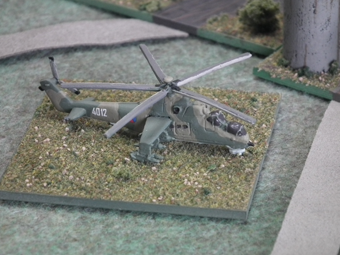
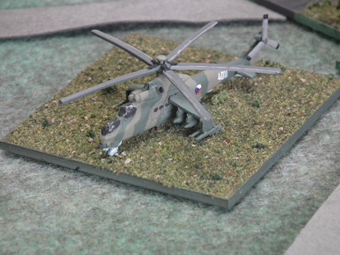
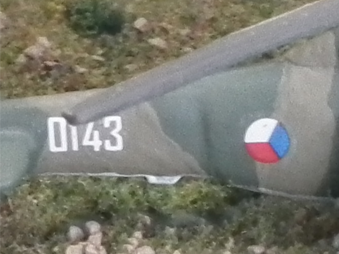
Whop whop whop! An iconic image of the Soviet military-industrial complex, who doesn't love the look of the Mil-24D (Hind-D in NATO-speak)? Number 4012 shown to the left served with the 4th Army's 51st Helicopter Regiment, being one of the very first batch of Hinds to arrive, in 1978. Unfortunately, it was destroyed in an accident in 1985 while chasing an American AH-1F Cobra helicopter along the German border. The crew survived, although the pilot was pensioned off because of his injuries. Cunningly (?!), I've called it 4011 on the other side - 4011 was also part of the initial 1978 batch, and served right through 80s and was later a component of the Czech Republic's military forces. The roundel (on the 4012 side, hidden by the rotor) is a WW2 Dutch decal from I-94 Enterprises, you can see a close up of it to the right, on craft no. 0143. On the other side, I had to invert the decal to leave just the white showing, and paint the red and blue over the top, because the orientation is opposite to that on the other side of the aircraft, so that the blue still faces forwards (to be more accurate, it is the other side's orientation that is reversed from the normal orientation of the roundel, which is blue to the left, but that is how the Dutch one is). The model's base is 60 mm per side, and it is a squeeze to get the whole thing, including rotors, onto the base without any overhanging pieces.
Not many Hinds served in the Czechoslovakian military: 28 Hind-Ds (plus
2 trainers) and 32 Hinds-Es (Mi-24V); and not all of these together at
the same time - 4012 for example had been written off several months before the first Mi-24Vs had arrived. Some have now been donated to Afghanistan after the Czech forces left them behind in 2007. Hind-Ds are Army-level assets as far
as the 3rd division is concerned. With an ATGW factor of 4, Hind-Ds are
fairly effective aginst tanks, but they are correspondingly expensive in
terms of points...
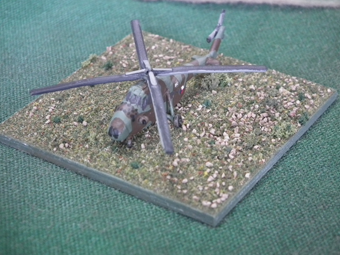

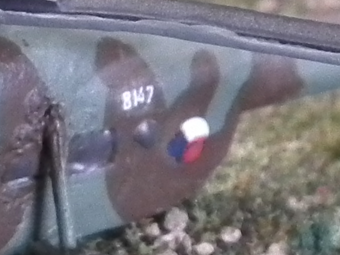
No. 8147 was a Mil Mi-4, or Hound in NATO-speak, serving with the 4th Army's 51st Helicopter Regiment, based in Prostějov (that's Prostejov with an inverted circumflex over the "e" if something is wrong with the Czech orthography there). During the late 70s and early 80s, the 3rd Division technically had no organic helicopter assets; these being provided by the 51st Regiment, as needed, but in 1985, the Division's helicopters were formally assigned their own helicopter squadron, the 3rd. However, the squadron had only Mi-2s on its books, as the last Mi-4s were withdrawn in 1985; 8147 was one of these last survivors. Its main function was light transport: a Mil-4 was just sufficiently large to carry a GAZ-69 jeep internally, it could also carry light guns such as the BzK vz.59, and in an earlier time, it could cope (just) with a slung ZiS-2 57 mm AT gun. The Division's deep recon platoon was also something that could be earmarked for transportation, to clear roadblocks, etc. in front of the Division's advance.
Nobody makes an Mi-4 model in 1:300th scale. This is actually a heavily
modified H&R Westland Wessex: the Wessex' body is longer but its main rotor is
smaller so it sort of evens out! I sliced off the Wessex' cowlings below the
cockpit and turned them around 180 degrees so they are now intakes. I took off
the tail rotor from the port side, sliced of one blade to make it 3-bladed, not
4, and reattached it on the starboard side. I filed down the nose to make it
fit the Mi-4's profile more (it could have done with even more filing). I moved
the main wheels more to the rear, and moved the rear wheel to the front (joined
by a second front wheel made from the Wessex' main rotor hub cap). I also
hacked and filed out much of the lower rear superstructure to make the rear a
boom rather than a more solid body; this took ages. Overall, I'm rather pleased
with the result, but I'm glad I only need a single model for the 3rd, because it
was a serious amount of work. Even the numbers took a lot of work to put on -
they are slightly less than one millimetre high!
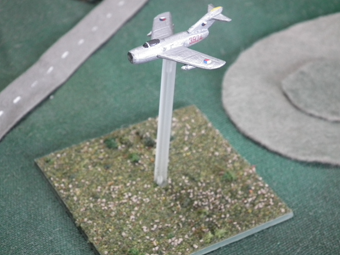
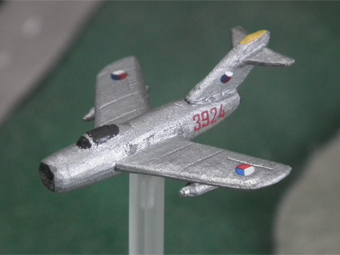
I had thought number 3924 was a MiG-15bisSB from the Czechoslovakian 10th Air Army's 30th Fighter-Bomber Regiment, one of four Fighter-Bomber Regiments that operated through the 1970s and 80s, but with further research it appears it was actually a plain MiG-15bis and might not have even served with the 30th (I haven't been able to establish definitively yet which unit(s) it served with). The 30th started operating both the MiG-15bis and MiG-15bisSBs in 1958, and they soldiered on until 1982; the last unit to operate them. In gaming terms, despite their age, MiG-15s aren't too bad in the ground attack role: their 37 mm cannon plus twin 23 mm cannons can pack a reasonable a punch. They have very little bomb-hauling capability, however.
Unlike the other Czechoslovakian jets that moved from being fighters into the
ground attack role, the MiG-15s retained their bare metal finish right to the
end. I think it's because of this finish that this is my favourite model
airplane - it looks very different from everything else on the table. The
numbers, like all the others on my aircraft, are decals from I-94 Enterprises.
The bases of most of my fixed-wing aircraft are 60 mm square, which shows
how small the MiG-15 is.
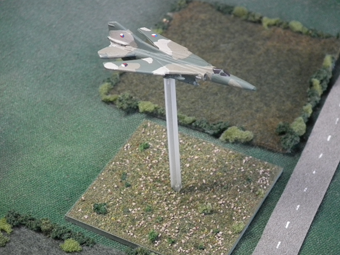
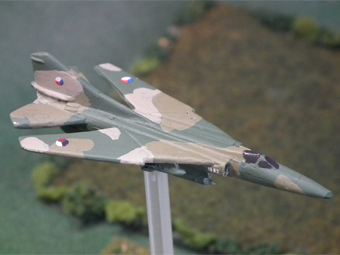
A much more modern machine, no. 1083 was a MiG-23BN serving with the 28th Fighter-Bomber Regiment from 1979; it was withdrawn from service in 1994, and scrapped at the end of 1995 after it had passed into the hands of the Czech Republic when that state came into being on New Year's Day in 1993. The 28th received its first MiG-23s in 1978, gradually replacing the Su-7s it was then operating. The MiG-23BN, or Flogger-H in NATO-speak, is a useful ground attack machine due to its decent ordnance capacity coupled with a wide variety of weapon loads. Even lowly Czechoslovakians can field anti-radiation missiles from 1980: IIRC, the entire complement of NATO forces in Germany had only two squadrons of planes capable of doing that at the same date.
Putting the (minuscule) numbers on this H&R model wasn't easy due to the limited
space available (the wing is necessarily too thick compared to the prototype,
limiting the space on the intake cowlings). I'm not sure how much use I will
get out of this model. I can't find any hard evidence for the existence of AGCs
in the Czechoslovakian Army, and being WarPac2, if you are without an AGC, you
basically need a 6 to call in an air-strike (with the notable exception of
pre-planned strikes under a deliberate attack situation using Keith McNelly's
scenario generation system). That's not good odds, and the better your
aeroplane (i.e the more points its costs), the harder it is to justify the
gamble.
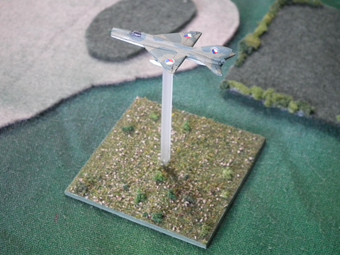
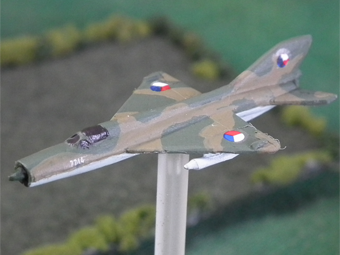
No. 7714 was a MiG-21MF assigned to the 6th Fighter-Bomber Regiment from 1973. It passed into Slovakian hands in 1993, and is currently preserved in the Aviation Museum in Košice, Slovakia's second largest city (that's Kosice with an inverted circumflex over the "s" if something is wrong with the Slovakian orthography there). It was built in Moscow in 1973, and last flew in December 2002, with just under 1527 flying hours on its books. The MiG-21MF had an internal 23 mm cannon, unlike many earlier models, but was not a dedicated fighter-bomber. Some however were nethertheless assigned to Fighter-Bomber regiments, and some, like 7714, were given fighter-bomber-style camouflage schemes.
All the planes shown so far I based up in a single day, and I made a mistake in
doing so - I forgot to put an temporary cover around the transparent support
rods I had so laboriously affixed to them, so when I sprayed them with my
standard matt varnish, it coated the rods and fogged them up. I'll have to see
if it can be gently scraped off. In game terms, MiG-21s make for relatively
poor attack aircraft, but that can be handy, as it means they cost very few points, and if you have a few points left over in your OOB, you can include one just on the off-chance you get that 6...
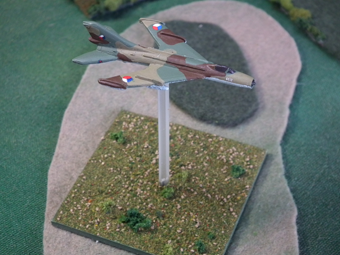
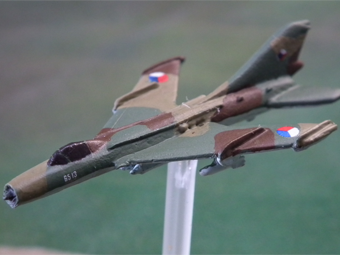
No. 6513 was an Su-7BKL serving with the 20th Fighter-Bomber Regiment from 1967 until 1990, when it was placed directly into the collection of the Aviation Museum Kbely in Praha (Prague). The Su-7 was designed as a supersonic fighter, but was reworked as a ground attack aircraft. This legacy meant that, despite its relatively large size, it could carry only a limited load of weaponry, and only over a short range. At least that means it's cheap, points-wise, in a game. Su-7BKLs had JATO rockets to assist taking off, unlike the somewhat more numerous Su-7BMs that also served with the 10th Air Army; they also had skids to enable them to better handle landing on rough fields.
The 20th Fighter-Bomber Regiment had the distinction of being Czechoslovakia's
only nuclear-weapons capable aircraft formation. A select few Su-7BMs (and
later Su-22s) were earmarked for carrying nuclear bombs, although Czechoslovakia
itself controlled no such devices; they were to be provided by their Soviet
masters in wartime.
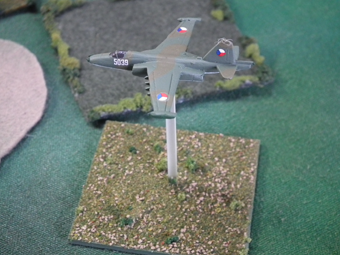
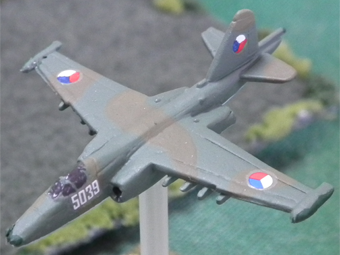
Ah, now we're talking! Frogfoot ahoy! No. 5039 was an Su-25K that arrived at the 30th Fighter-Bomber Regiment in 1987, 3 years after the first four planes. It was retired in 2000 with flying 945 hours on its books, having been manufactured in Tblisi, Georgia, in 1984. It was put in storage in 2001, and then apparently sold off in the US, of all places, in 2004; if I read my source material correctly, it currently seems to be located in Richmond Heights, Ohio. The 30th was renamed as an Air-Attack Regiment in 1985 once it had received its first full squadron's worth of Su-25s, since it no longer operated mere fighter-bombers, reviving a unit designation not used for other 20 years.
Since Frogfoots only arrived in 1984, and I tend to play games earlier than
this, this model probably won't see too much on-table action. But if I
am playing a mid-80s game, my ground troops are likely to be hopelessly
outclassed in terms of technology, and this might be the only thing capable of
taking out advanced enemy armour. As a dedicated ground-attack aircraft, under
the rules, it gets two separate beaten zones: one for the cannon, and one for
other ordnance. Of course, it is correspondingly expensive in terms of
points...
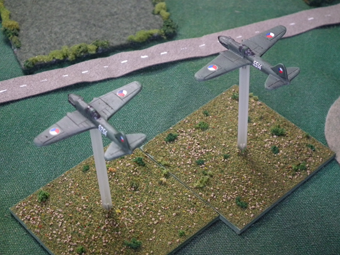
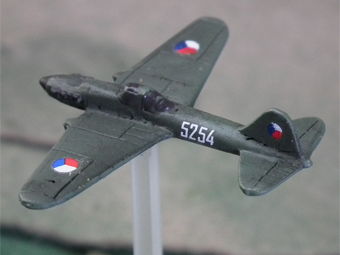
And now for something completely different... These are B-33s, otherwise known as Ilyushin Il-10Ms, which were licence-produced in Czechoslovakia in the early 50s, with production stopping in 1955, by which time they were looking somewhat anachronistic: they were withdrawn from frontline service in 1962, to be relegated to training roles only, and ceased flying completely the next year. Although something like 1200-odd were produced, by 1960, only the 32nd Air-Attack Regiment still flew them. B-33s had no less than four 23 mm cannon for ground attack duties, plus a 20 mm cannon for rear defence. As dedicated ground-attack aircraft, like the Su-25K, they receive 2 beaten zones, although the second one is either a poor (factor 5) rocket attack, or a piddly bomb attack (factor 6 - well, it would be if the scenario system allowed that; so a merely poor 5 it will have to be) .
The numbering of these two planes is something of a mystery to me; all the
examples I can find allocated to particular units are in the form AB-xy, where A
& B are letters, and x & y are numbers. These are actually Il-2 models; the
Il-10M is very similar in appearance, however. Alas, I am unlikely to
ever play a 50s-era game, so these would have been more usefully painted up as WW2 planes aiding my 1945 Czechoslovakia 1st Corps (WW2) Spearhead force that I am currently putting together. The 1st Corps had an associated Czechoslovakian Mixed Air Division with it, comprising three regiments. The 1st and 2nd were fighter units, while the 3rd was an Air-Attack Regiment: the great majority of its planes were Il-2s.

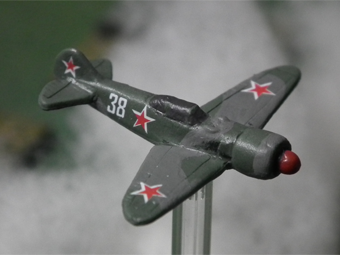
Continuing the WW2 theme, this is a Lavochkin La-7. I've painted it up as if it was from the 1st Air Fighter Regiment of the 1st Czechoslovakian Mixed Air Division: that's part of the Corps' 2nd Brigade it's over-flying. Since the division was under operational control of the Soviet 8th Air Army, and most of its pilots were Russians, its aircraft were painted in standard Soviet markings. This also allows me to use it as a genuine Soviet aircraft if I play a Soviet force. Unlike most of my aircraft, its small size means it can almost fit entirely within a 30 mm square base: its 9.8 m wingspan translates to 32 mm at 1:300 scale (the actual model's wings are 31 mm across). I'd prefer it if the model was the earlier La-5FN instead, as these saw much more extensive service in the Division, but an La-7 is what H&R produce; and in any case, they are visually very similar.
The La-7 entered Soviet service in 1944; however until the very end of April 1945 only two served with the Czechoslovakia 1st Air Fighter Regiment, on the 28th half the force was re-equipped with them, replacing La-5FNs. Actually, I have no idea if number 38 even was an La-7 as opposed to an La-5FN during the subsequent Prague Offensive: when the war ended, the aircraft received Czechoslovakian roundels rather than Soviet stars, so there is a just a two-week window in which the aircraft could have been photographed for posterity to document one way or the other... Incidentally, the regiment was commanded by the remarkable František Fajtl (that's Frantisek Fajtl with an inverted circumflex over the "s" if something is wrong with the Czech orthography there) - take a minute or two to look him up; you won't regret it. The La-7 was a fighter, not a ground-attack aircraft, but by May 1945 German air opposition was thin on the ground - and even thinner in the air! The regiment conducted sweeps over German-held territory during the Prague Offensive, but I'm not sure if they encountered any opposition in the air. With three 20 mm cannon it had some utility as a vehicle-buster; it could also carry 200 kg of bombs. A single example is preserved in the Aviation Museum Kbely in Praha (Prague), it's painted up as number 77.
Back to my photos top page.